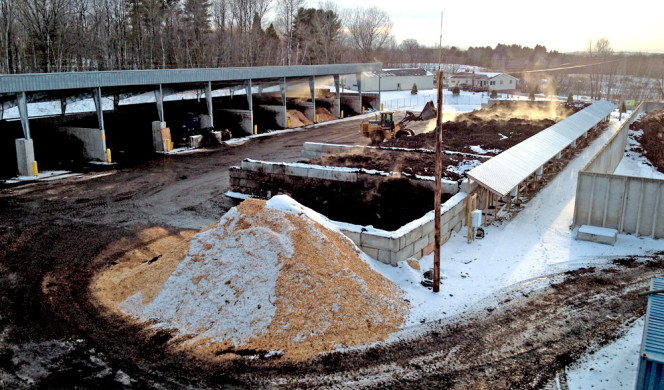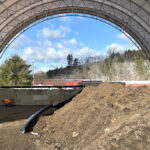Vermont’s Act 148 makes state first in the nation to mandate residential food scraps recycling and pay-as-you-throw solid waste collection to incentivize diversion.
Robert Spencer
BioCycle March/April 2014
The clock is ticking for implementation of Vermont’s Universal Recycling law that was passed in July 2012. Act 148 bans landfill disposal of plastic, aluminum and metal containers, tin foil, paper/cardboard, leaf/yard residuals and food scraps. The law gave the Vermont Agency of Natural Resources (ANR), towns, solid waste districts, waste haulers and waste generators time to develop detailed plans and guidance documents before the July 1, 2014 start date.
The unanimously supported bill was driven by a recognition that the state’s overall recycling rate had stagnated at 30 to 36 percent for more than 10 years. The legislature, working with a number of the state’s solid waste district managers, and ANR staff, crafted legislation intended to create a solid waste recycling system that provided more consistent services statewide using financial incentives of variable rate pricing for trash disposal. A key to accomplishing the state’s 50 percent recycling goal is inclusion of food scraps and yard waste in the list of materials banned from landfill disposal.
There was also concern that Vermont might have only one commercial landfill operating within its borders when a commercial landfill in central Vermont closed, which became reality in 2013. Currently, the only commercial landfill in the state — Casella Waste System’s Coventry landfill — is located near the Canadian border. As a result, municipal solid waste from the central and southern regions of the state is being hauled to landfills in neighboring states.

The largest generators of food scraps (>104 tons/year) must start separating them on July 1, 2014 if there is a permitted composting facility within 20 miles to receive them. Green Mountain Compost in Williston, Vermont, a municipally-funded operation, is permitted to take food scraps. (Photo courtesy of Green Mountain Compost)
The organics diversion portion of the law starts with this objective: “…the requirements of this chapter shall be managed according to the following order of priority uses: Reduction in the amount generated at the source; Diversion for food consumption by humans; Diversion for agricultural use, including consumption by animals; Composting, land application, and digestion; and Energy recovery.”
The law makes Vermont the first state in the U.S. to require that all food scraps be recycled, including residential sources, by 2020. Mandatory compliance with the law is phased in over a series of six years, beginning with the largest generators of organic waste (see sidebar). The law only requires diversion if an organics recycling facility is within 20 miles, but that requirement ends in 2020 in anticipation of development of a statewide organics processing infrastructure. The 20-mile requirement is further defined by stating that the facility must have “available capacity and is willing to accept the food residuals.”
According to a study on the impact of Act 148 on solid waste management in Vermont conducted by DSM Environmental for ANR (DSM Environmental, 2013), there are 14 composting facilities permitted to process food scraps in Vermont, with an estimated permitted capacity up to 35,000 tons/year. The DSM estimate does not include generators with on-site composting systems such as a number of colleges. The DSM report contains a map showing the 20-mile radius around each facility, demonstrating that most areas of the state, particularly the more densely populated areas where larger food scraps generators are generally located, are within 20 miles of a permitted composting facility.
The DSM report also identified 17 farm-based anaerobic digestion (AD) facilities operating in Vermont, with one additional facility under construction and several in the planning stages. In addition, a number of wastewater treatment plants in Vermont utilize AD technologies that could potentially accept slurried food residuals. Currently very little commercial or institutional food residuals are processed at these AD facilities, primarily because food residuals would need to be converted to a slurry, with potential contaminants removed. However, a number of Vermont farm digesters receive industrial food residuals in liquid form from Vermont ice cream and cheese manufacturers, as well as tanker trucks of liquid food residuals from the Boston area and Maine. As Act 148 is implemented, it is likely that a number of these dairy digesters will consider the potential energy benefits of adding slurried food residuals.
The report also includes estimates of food scraps generation. As of 2014, there are 18,600 tons of industrial, commercial and institutional (ICI) food scraps and 41,500 tons of residential food scraps generated in Vermont. However, it is not known how much of the permitted composting capacity for food scraps is actually being utilized.
Regarding the need for additional organics materials processing capacity, the DSM report made an assumption that each county (14 in total) would need at least one centralized composting facility. Using vendor and industry capital costs for a variety of new facilities of varying capacity, ranging from 1,000 tons/year to 10,000 tons/year, including bulking agents, a total of “roughly $20 million (rounded) in new investment will be necessary to process organics estimated to be diverted for off-site processing under the ban by 2020,” states the report.
Curbside Collection Considerations
Act 148 makes Vermont the first state to require variable rate pricing, or so called pay-as-you-throw (PAYT), to incentivize the public to recycle. All communities will be required to have an ordinance to implement this “carrot” approach by 2015. Most communities will rely on their solid waste district to enact such an ordinance. ANR has issued a guidance document and draft ordinance to assist with this important requirement.
Many communities are already utilizing PAYT programs at transfer stations (opting to self-haul versus using a collection service), with 32-gallon bags typically charged at the rate of $3/bag; a few charge as much as $6/bag. Starting in 2015, all communities and haulers will be required to utilize variable rate pricing, including service to households.
One of the most controversial aspects of Act 148 is that trash haulers will be required, starting in July 2015, to pick up recyclable material at the curb “at no additional charge” to their residential customers. The intent is to make PAYT curbside collection programs “cost-neutral” for collection of recyclable materials. Although ANR recognizes there will be additional costs to the haulers, they do not want haulers itemizing a charge for collecting the recyclables with the trash. Revised language is currently being considered that would allow haulers to “bundle” costs, similar to the way TV, phone and Internet charges are bundled.
Although PAYT is the primary mechanism for promoting compliance with Act 148, ANR is also publicizing that the law makes it illegal to throw recyclable materials into landfills, and that there will be enforcement actions, particularly based on complaints about noncompliance. No specific penalties are provided for in Act 148, but ANR believes the state, towns and solid waste districts have sufficient regulatory authority to enforce the law. ANR emphasizes that it will rely primarily on education and outreach to achieve the law’s goals.
Curbside collection of food scraps can be billed separately due to the more complex nature of collecting and hauling organic materials, which will likely require new collection trailers or trucks. Act 148 allows haulers to subcontract with other haulers to collect food scraps, so there is some potential for development of specialized organics collection businesses.
ANR 2013 Report To Legislature
Over one year following enactment of Act 148, allowing for completion of a systems analysis of the infrastructure and capital costs required to implement the law (the DSM report), ANR released a report to the legislature in November 2013 with the following primary recommendations:
Further Utilize Extended Producer Responsibility Strategies
“Extended producer responsibility (EPR) requires that a producer’s responsibility for its products and packaging extend to postconsumer materials management. This shifts the financial and management responsibility, with government oversight, from the public to the consumers and producer, providing incentives to producers to consider the environment in the design of their products and packaging. Existing Vermont EPR programs include: fluorescent (mercury) lamps and thermostats, electronics, automobile switches, dry cell batteries and paint. A voluntary Product Stewardship (PS) program collects rechargeable batteries (lead and nickel cadmium) which are banned from the landfill. The oldest product stewardship program in Vermont is the bottle bill, which has been in existence for more than 40 years. Vermont’s EPR programs have been effective for diverting toxic materials from landfills and providing convenient options for state residents.”
To evaluate other EPR programs, such as batteries and carpet, ANR will host a stakeholder process over the next year to direct legislative consideration of additional programs to increase diversion of difficult to manage materials and offset the expenses incurred by municipal solid waste districts and taxpayers.
As for the on-going debate over the future of the state’s bottle bill, “ANR will also collect recycling data to determine if there is a need to modify the bottle bill. Act 148 requires ANR to report to the legislature at least every two years on the status of the law and its effectiveness in reaching the recycling goals.”
Level the Hauling Playing Field
“Act 148 currently exempts commercial haulers with collection vehicles that have a one-ton curbside rating or less. Unless removed from the law, this exemption will allow a subset of commercial haulers to avoid compliance with the recycling and organics collection benchmarks if they meet the one-ton exemption. ANR recommends eliminating the one-ton exemption.”
Fund New Universal Recycling and Organics Infrastructure
Act 148 was passed without funding for implementation given consensus that the law would have had a tenuous fate had it been subject to funding provisions. To address this challenge, ANR’s report states: “The DSM report estimates that $20 million will be needed over the next nine years to support organics processing infrastructure; another $17 million is needed for trucks and carts to collect both recyclables and organics. Much of this investment will be made by the private sector, with additional investments and funding from solid waste districts. The state could provide support and seed money to help instigate and guide strategic investments furthering the goals of Vermont’s Universal Recycling law.
One option for raising state funds to pass on to the private sector and solid waste districts would be to increase the franchise fee created in 1987. The funds could be used for a grants/loans program for private and public sector equipment investments necessary for implementation of Act 148. Vermont’s solid waste franchise fee is collected based on the tonnage disposed of in the landfill. In 1987 it was set at $6/ton, creating the Solid Waste Management Assistance Fund. The Consumer Price Index has doubled since that time. If the franchise fee was increased to $12/ton, $3.3 million/year in additional revenue would be generated that could be directed into a dedicated grants/loans program. Moreover, the additional cost to Vermonters would be modest: based on an estimated per capita disposal rate in Vermont of 0.66 tons/year, the additional cost per individual would be less than $4 annually.
A significant consequence of Act 148 is increased collaboration between public and private sector waste managers, particularly the hauling industry. Numerous stakeholder meetings have identified the specific challenges, and recommended solutions, to implement this first in the nation program.
Robert Spencer is Executive Director of the Windham Solid Waste Management District in Brattleboro, Vermont, and a Contributing Editor to BioCycle. The DSM report cited in this article can be downloaded, www.anr.state.vt.us/dec/wastediv/solid/Act148.htm#FinalReport













